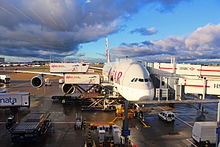


The airport apron, apron, flight line, or ramp is the area of an airport where aircraft are parked, unloaded or loaded, refueled, boarded, or maintained.[1][2][3] Although the use of the apron is covered by regulations, such as lighting on vehicles, it is typically more accessible to users than the runway or taxiway. However, the apron is not usually open to the general public, and a permit may be required to gain access. An apron's designated areas for aircraft parking are called aircraft stands.[4]
By extension, the term apron is also used to identify the air traffic control (ATC) position responsible for coordinating movement on this surface at busier airports.[citation needed] When the aerodrome control tower does not have control over the apron, the use of the apron may be controlled by an apron management service[5][6] (also known as apron control or apron advisory) to provide coordination between the users. Apron control allocates aircraft parking stands (gates) and communicates this information to tower or ground control and to airline handling agents; it also authorises vehicle movements where they could conflict with taxiing aircraft such as outside of painted road markings.[7] The authority responsible for the aprons is also responsible for relaying to ATC information about the apron conditions such as water, snow, construction or maintenance works on or adjacent to the apron, temporary hazards such as birds or parked vehicles, systems failure etc.[3] Procedures should be established for a coordinated information provision between the aircraft, vehicle, apron control unit and ATC to facilitate the orderly transition of aircraft between the apron management unit and the aerodrome control tower.[5][8]
The apron is designated by the ICAO as not being part of the maneuvering area but included in the movement area.[3] Aircraft stand taxilanes (providing access to aircraft stands) and apron taxiways (taxi routes across the apron) are located on the apron.[3] All vehicles, aircraft and people using the apron are referred to as apron traffic.[6]
- ^ FAA Advisory Circular 120-57A – See page 2 for definition of Apron (Ramp).
- ^ "IATA Reference Manual (IRM) for Audit Programs 11th edition". IATA.org. International Air Transport Association. Archived from the original on 2 May 2021. Retrieved 2 May 2021.
- ^ a b c d "Doc 4444 Procedures for Air Navigation Services — Air Traffic Management (PANS-ATM)" (PDF). OPS Group. 2016. p. 23, 30, 147. Archived from the original (PDF) on 6 May 2021. Retrieved 2 May 2021.
- ^ Certification Specifications (CS) and Guidance Material (GM) for Aerodromes Design CS-ADR-DSN (PDF), European Aviation Safety Agency, 27 February 2014, p. 5,
'Aircraft stand' means a designated area on an apron intended to be used for parking an aircraft.
- ^ a b International Civil Aviation Organization (2018). "ICAO Annex 14, Aerodromes - Volume 1, Aerodrome Design and Operations" (PDF). International Civil Aviation Organization. pp. 27, 229–230. Retrieved 2 May 2021.
- ^ a b Kumar, Bharat; DeRemer, Dale; Marshall, Douglas M. (2004). An Illustrated Dictionary of Aviation. New York: McGraw-Hill. p. 69. ISBN 978-0-07-139606-6.
- ^ Smith, David (2015). Air Traffic Control Handbook (10th ed.). Manchester: Crécy. p. 126. ISBN 978-08597-91830.
- ^ Runway and Ground Safety Working Group (21 November 2018). "Implementation of Aerodrome Safety Priorities and Objectives in the MID Region: APRON MANAGEMENT – DRAFT REGIONAL SAFETY ADVISORY" (PDF). Cairo, Egypt: International Civil Aviation Organization. p. 14.